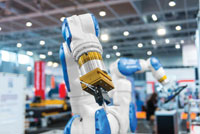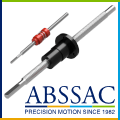
Posted to News on 25th Jun 2019, 00:00
Functional safety
A safety related control function is one of the measures that makes a contribution to the overall reduction of risk with machinery. As digitalisation and automation progress, so electrical, electronic or programmable electronic systems (E/E/PES) are used increasingly in the field of safety applications.

Consequently, in the machine industry, the significance of functional safety has increased continuously. In this sector, the focus of interest has always been the safety of operating and maintenance staff. The other goal has been to minimise the costs of operation and servicing or maintenance. Conse-quently, machine manufacturing and operation are subject to a host of regulations and requirements.
Machinery manufacturers must show compliance with the European Machinery Directive 2006/42/EC. The harmonised standards EN ISO 13849 (Safety of machinery – Safety-related parts of control systems – General principles for design), Parts 1 and 2 and EN 62061 (Safety of machinery. Functional safety of safety-related electrical, electronic and programmable electronic control systems) cover the safety related parts of control systems within a machine, and can be used to achieve compliance in the field of functional safety.
In order to demonstrate compliance with the Machinery Directive, machine builders can choose to work to EN ISO 13849 or EN 62061. EN 62061 applies to electrical, electronic and programmable electronic control systems, and its principles can be applied to other technologies as well. EN ISO 13849-1 is not technology specific, so it can be applied for electrical, pneumatic, hydraulic and mechanical safety systems. To add a further layer of confusion, EN ISO 13849-1 also doesn’t make it completely clear which requirements apply to a particular situation, resulting in machine builders often misinterpreting how they should apply the standard.
Over the years, both ISO 13849-1 and EN 62061 have seen revisions, but the long-term plan was to simplify the process by merging the two standards, thereby making them more accessible for the machinery community. However, following the collapse of this project, the ISO published an amended version of its standard (EN ISO 13849-1:2015) in December 2015. To address the levels of confusion in the market, the IEC and ISO have issued technical reports (IEC/TR 62061-1 and ISO/TR 23849) – ‘Guidance on the application of ISO 13849-1 and IEC 62061 in the design of safety-related control systems for machinery’.
In recent years, the requirements imposed on machines and machine systems have grown more comprehensive and complex, as digitalisation and automation progress. Growing complexity and connectivity bring new requirements for machinery functional safety, with previously separate applications growing closer together. New applications of functional safety are also emerging, such as collaborative robots working in the same workspace as humans. This innovative field requires a holistic approach to functional safety, emphasising the need for relevant expertise and years of experience, in both application specific and generic systems.
These technologies have contributed significantly to greater efficiency and a higher degree of automation, improving operability and profitability. Alongside this, the importance of functional safety within the machinery industry has increased continuously, as the safety system contributes significantly to risk reduction and must therefore be aligned to these more versatile and complex applications.
The increasing connectivity of systems, plus the growing possibilities of remote control further requires suitable approaches to protect systems against unauthorised access and safety-relevant manipulation of the safety functions that are embedded into both hardware and software.
In the past, dangerous machinery movements could be reliably stopped by opening one of the monitored doors in the safety guarding. Some safety applications are starting to move away from access prevention and the reliable shutdown of machines, to the automated identification of people to allow for continuous machine operation, in order to minimise disruption to the production line. With such high levels of automated safety, the safety related parts of controls systems will become more complex. This will of course escalate with Industry 4.0 and smart manufacturing.
However, as state-of-the-art moves on at a dramatic pace, with innovations such as Industry 4.0’s smart factories, new components and systems frequently become available which are too technologically advanced for current standard requirements.
Both IEC 62061 and ISO 13849 are therefore in the process of being significantly updated. At the time of writing, publication dates are not yet confirmed, but we should see something during the latter part of 2019. In the meantime, when using either standard, machine builders need to identify the individual safety functions of a machine, and then assign performance requirements against each of these to ensure that they comply. While functional decomposition (breaking each function into further sub systems) is a detailed and time consuming process, it can help with the calculations and also help to ensure that nothing is missed.
An analysis by the HSE of incidents connected with safety related parts of control systems revealed that poor design and implementation, together with incorrect specification, accounted for 59% of the causes identified. That represents a significant amount of downtime for factories that rely on machinery to do business effectively. These are exactly the types of problem that a full validation process could have uncovered before the control system went into service. Consequently, end-users of machinery are therefore increasingly demanding full validation on a machine before they purchase, and it is therefore important that they understand what this involves.
EN ISO 13849-2 spells out the basic validation requirements very clearly in Section 4, Validation Principles. It states that: “The validation shall demonstrate that each safety-related part meets the requirements of ISO 13849-1, in particular:
- The specified safety characteristics of the safety functions provided by that part, as set out in the design rationale, and
- The requirements of the specified performance level (see ISO 13849-1:2006, 4.5):
- Validation should be carried out by persons who are independent of the design of the safety-related part(s).”
Carrying out the calculations required by EN ISO 13849-1 and EN 62061 remains a complex task. While there are software packages that help to guide users through the compliance process, the growing complexities caused by ever greater technology innovations and integration means ensuring compliance with these standards is becoming a more complex and resource hungry task.
















